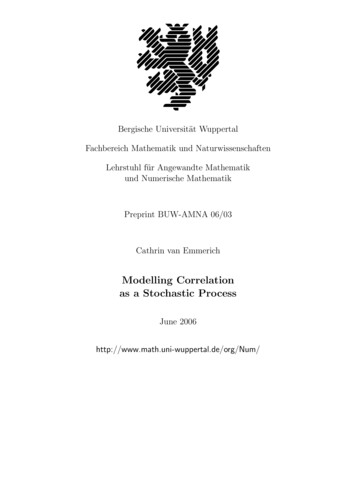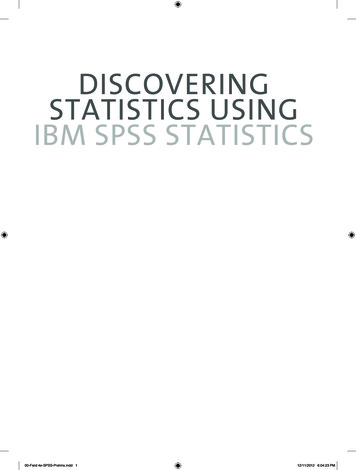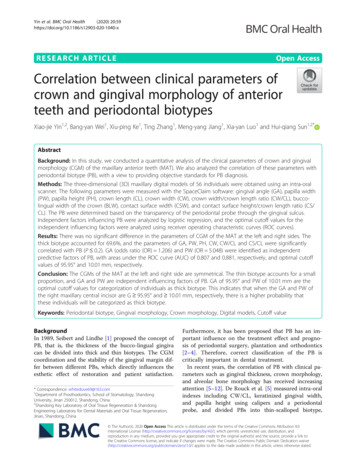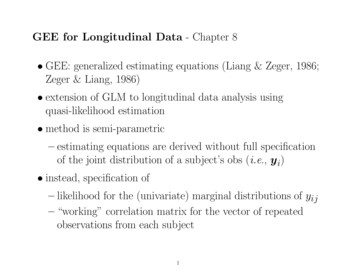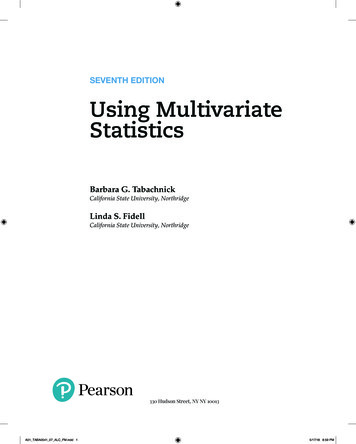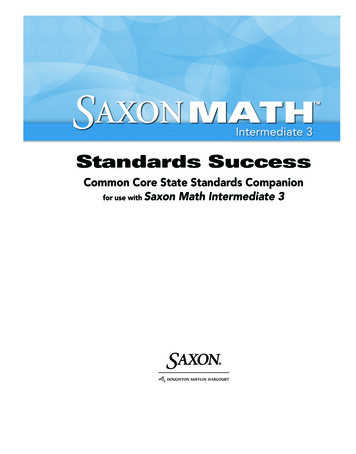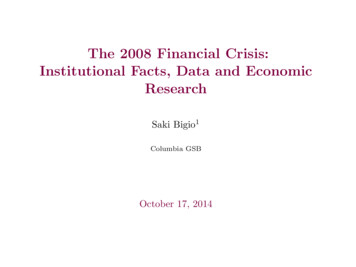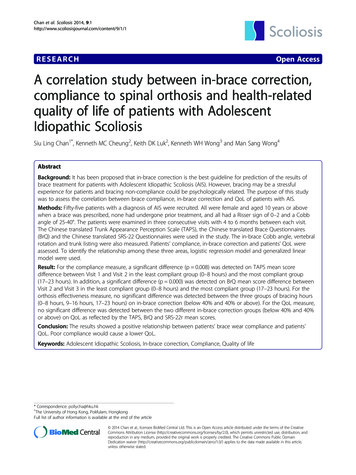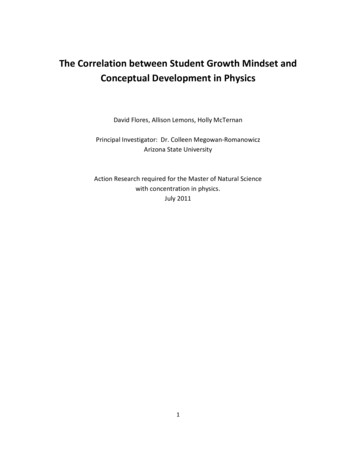
Transcription
The Correlation between Student Growth Mindset andConceptual Development in PhysicsDavid Flores, Allison Lemons, Holly McTernanPrincipal Investigator: Dr. Colleen Megowan-RomanowiczArizona State UniversityAction Research required for the Master of Natural Sciencewith concentration in physics.July 20111
Table of stractRationaleLiterature ReviewStudy MethodDataResultsConclusionField ReportsInvestigator 1 David FloresInvestigator 2 Allison LemonsInvestigator 3 Holly McTernanImplications for Further StudyWork CitedFurther ReadingAppendix A: Mindset Survey (PBS)Appendix B: Interview with Dweck (short article given to students)Appendix C: Mindset short vignettes for use in classroomAppendix D: Target words for essay scoring and teacher rubricAppendix E: Investigator 2 Exit ticket templateAppendix F: Investigator 3 Interview sample excerpts2
AbstractResearch by Carol Dweck of Stanford University has demonstrated that all learners haveone of two fundamental sets of beliefs about learning and the process of learning. Dweckrefers to these beliefs as a mindset1. (Dweck, 2008). Dweck has shown that students with thebelief set termed a growth mindset reach a greater level of understanding in a junior high mathclassroom and in college pre-med classes. She has shown that it is possible to predict whatkind of grades that student will likely earn in junior high if the student’s mindset is known.(Aldhous,2008)At Arizona State University, the investigators have noticed that, even in a modelingphysics classroom, large gains in conceptual understanding may require some characteristicsthat are typical of individuals with a growth mindset. Examples of these characteristics are awillingness to let go of fear of failure and foolishness, an ability to persevere, and a value ofwork for understanding over work for points.Using the Force Concept Inventory (FCI), physics students in our study were tested forconceptual understanding before and after a modeling mechanics class. They were alsosurveyed and observed to determine their mindset. An attempt was made to correlate FCIgains with mindset for the participants in the study whose mindset could be clearly determined.The results indicate that a student with the growth mindset will have a greater probability ofachieving higher gains on the FCI than a student with a fixed mindset.RationaleThe investigators have observed that physics is a field considered by many to be one ofthe most difficult and frightening subjects. Additionally, the Modeling Method of Physicsrequires greater interaction among students with greater vocalization of thinking andquestioning than does a traditional approach to teaching Physics. It also requires greaterperseverance since understanding is not simply handed over to a student by a transfer ofinformation. If the Modeling Method of Physics is to be maximally effective, students shouldhold a set of “beliefs about what they should value in the learning setting – away from pointsand right answers and toward deep and well-connected understanding” (Megowan, 2007). Butperseverance is one area of the learning experience that is different for fixed and growthmindset persons. Writing of the characteristics of the fixed mindset person, Dweck relates that,1Dweck describes the mindsets at length in her book. Briefly put the two labels she uses are “fixed mindset” and“growth mindset”. Fixed mindset refers to the belief that intelligence is fixed and effort and perseverance are notfactors in learning. Growth mindset refers to the belief that intelligence is formed through effort andperseverance.3
“If things get too challenging - when they [fixed mindset] are not feeling smart or talented –they lose interest.” (Dweck, 2006) Pre-med students who needed to pass a challengingchemistry class in order to move forward in the field lost interest and enjoyment in their studiesthe harder it became unless the material came easily to them. Students with a growth mindsetwere more motivated to study the more challenging material. (Dweck, 2008). It seemsreasonable, based upon Dweck’s findings and the culture of the effective modeling classroommentioned above, that students entering such a course might also have predictable grades iftheir mindset were known.Every physics teacher has students with a range of mindsets. This range has beenidentified by Dweck to be about a 50-50 ratio, but she has also pointed out that in a “highpower”2 situation, the mix will shift so that more students display a fixed mindset and fewerstudents a growth mindset. (Aldhous, 2008) Thus, if there is a valid model that describes therelationship between the growth mindset of a physics student and the student’s conceptualunderstanding of physics as it is measured by the Force Concept Inventory, then it would beworthwhile for a teacher to take the time and effort to make students aware of the mindsetmodel and its advantage. While it was outside of the scope of our study to change the mindsetof our students, Dweck has further proved that just as any beliefs can be changed by newinformation, mindset can be changed by even the awareness of the growth mindset advantage.(Dweck, 2008; Blackwell, et al 2007; Good, et al 2003).Literature ReviewIn this study, the correlation between mindset of physics students and FCI gains isinvestigated. A “growth mindset” is a belief system in which basic qualities, abilities, andtalents are things that can be cultivated through effort. Someone with a growth mindset wouldseek new challenges and experiences as a way to become more skilled and talented and as apathway to future success. Persons with a growth mindset try new things and see little value inrepeating what they have already mastered. A “fixed mindset” is a belief system in which basicqualities, abilities, and talents are predetermined by genetics or other things beyond controland these cannot be changed. With a fixed mindset there is no point in taking on newchallenges or trying harder, because one might discover or confirm that one is inept in that areaof challenge. Persons with a fixed mindset will do the same things they are good at multiple2Dweck spends a great deal of time discussing the high profile lives and careers of CEO’s and sports figures whohave earned ‘superstar’ status. The regular public praise for their work, huge salaries and bonuses, and opulentlifestyles go hand in hand with identification that the ‘superstar’ is solely responsible for their success. Dweckpoints out that this brings out the worst aspects of the fixed mindset in addition to attracting fixed mindsetpersons to such a role in the first place. (Dweck, 2006).4
times to affirm that they are good at them but will not try something new or difficult as thiswould not be affirming. Persons with a fixed mindset reported feeling smart when they did notmake mistakes, finished quickly, easily, and perfectly. Furthermore, they did not finish thingswhen they did not feel smart. (Aldhous, 2008). A reason for developing the Modeling Methodwas that the “social norms of conventional schooling can and should be rewritten” (Megowan,2007; Hestenes, 1997). In American classrooms, students have learned that the road to successis, “getting the answers right, and getting the teacher to give them points.” Colleen MegowanRomanowicz of Arizona State University points out, “By the time most students reach highschool, [they have identified] the classroom practices that will buy them the most points inexchange for the least effort.” (Megowan, 2007; Ames, 1988). The connection betweenmotivation and learning has been studied from a variety of perspectives and an assortment ofterminologies has been developed to describe these connections. (Pintrich, 2000). In studyingissues of motivation in mathematics education, it has been found that student goals fall intotwo categories. There are “ego/performance goals” which are extrinsic. Students aremeasuring their success against external rulers. These students are essentially motivated byearning points, peer respect, and gaining external desired rewards such as public honors andaccolades. Alternatively, there are “mastery goals” which are intrinsic. Students with masterygoals are measuring their success against internal rulers. These students are motivated by adesire to learn and become better at something. Those studying motivations in learning havefound that the latter types of goals are more likely to be linked to perseverance when materialand requirements of learning become challenging. (Middleton & Toluk, 1999; Butler, 1987). Inother research, the same connection between motivation and learning is proven yet theterminology used is self-efficacy. Levels of self-efficacy predict outcomes on tasks. Forinstance, individuals who believe they are capable of succeeding at a task would be given a highscore of self-efficacy. Furthermore, self-efficacy measures the attitude towards mastering thetask and the likeliness for perseverance. Persons do have varying levels of self-efficacy fordifferent areas of [performance. For instance a person who has high self-efficacy in footballmight not have the same level of self-efficacy in science. Dweck points out that a majordifference in the two mindsets is that persons with a fixed mindset and high self-efficacy in aparticular area seek challenges and persevere, but persons with the fixed mindset and low selfefficacy in a particular area will avoid challenge and have low persistence. Important for thisstudy is the research evidence that persons with a growth mindset seek challenge and persistregardless of their self-efficacy. This means that they can seek challenges and persist tosucceed in all areas, not solely in areas at which they already excel. (Dweck, &Leggett, 1988)It has been demonstrated that students can reach a higher level of achievement,satisfaction, and success when these students have a growth mindset. Dweck ran a study withyoung math students. One group was given tutoring and lessons in study skills. The other was5
given these things in addition to lessons in growth mindset development. When the workshopsended, students in the growth mindset group had improved math scores. Dweck explains,“They were now clearly doing better than the students who’d been in the other workshop. Thisone adjustment of students’ beliefs seemed to unleash their brain power and inspire them towork and achieve ” (Dweck, 2008).Worthy of note is that even with all the support given math students with no growthmindset training, the students with no mindset training did not improve. “Despite their trainingin study skills and other good things, they showed no gains.they were not motivated to putthe skills into practice. (Dweck, 2006; Blackwell et al, 2007).Each of the investigators has come to the realization that a large factor leading tostudent success is the use of the Modeling Method of High School Physics developed by DavidHestenes and Malcolm Wells at Arizona State University beginning in 1980. (Hestenes, 1987;Wells et al 1995) “Modeling Instruction in high school physics is nationally recognized as aprogram of excellence. It is grounded on the thesis that scientific activity is centered onmodeling: the construction, validation, and application of conceptual models to understand andorganize the physical world. The method utilizes experimental design, control of variables, andcalls for reasoning and application of skills in solving various kinematics and dynamicsproblems. There is strong use of student discourse, as evidenced by the need for students topresent and justify conclusions derived in the laboratory. Multiple strategies for problemsolving are encouraged, reflecting sensitivity to individual student differences and abilities.”One of the reasons that physics instruction was designed around physical models is thatstudent beliefs get in the way of their learning in a traditional instruction. (Hestenes, 1996).The beliefs referenced here are beliefs about physical systems. These incorrect beliefs includeideas such as “heavy items fall faster” or “bigger, heavier items push harder on smaller, lighteritems.” The Modeling method does an admirable job of addressing these false beliefs andhelping students overcome them. Dweck and others would say that beliefs about how personslearn and whether a person can learn something challenging are also important beliefs toaddress. Perhaps modeling instruction can be improved by attending to the false learningbeliefs held by students and helping them to overcome these as well. (Ames, 1982)Furthermore, it has been shown that in the Modeling Physics classroom, a keydeterminer of the success of the learning outcome is the quality of Socratic dialogue.(Megowan 2007, Desbien, 2002, Desbein, Wenning, Hestenes, 2000; Ames, 1982). Through thebenefits of dialogue, a better overall classroom response occurs. However, the dialogue mayprove elusive if students are afraid to look stupid in front of peers. ‘Fear of looking stupid’ is akey characteristic of a fixed mindset, but such a fear is less likely to exert itself in a growthmindset. (Dweck, 2006) Other researchers use different terminology but point out similarroadblocks to learning. “Performance-avoidance orientation” is used to describe the reluctanceof a student to become involved in a learning experience due to worries about the student’s6
performance in comparison to peers. In simple terms the student does not want to look‘stupid’. (Midgley, Kaplan, Middleton, 2001; Middleton, Midgley, 1997).Hestenes points out that “special measures may be required to engage reluctant orreticent students.” (Hestenes, 1996). One such special measure may be to help students betterunderstand their own beliefs about learning and how these affect them. Students with agrowth mindset may be able to overcome a reluctance to enter the dialogue process. In doingso, they may be better situated to learn the concepts taught in a modeling physics classroom. Aseventh-grade girl who participated in one of Dweck’s studies, here explains how a growthmindset changed her participation in her math class: “I think intelligence is something you haveto work for.it isn’t just given to you.Most kids, if they’re not sure of an answer, will not raisetheir hand to answer the question. But what I usually do is raise my hand, because if I amwrong, then my mistake will be corrected. Or I will raise my hand and say, ‘How would this besolved?’ or ‘I don’t get this. Can you help me?’ Just by doing that I am increasing myintelligence.” (Blackwell, Trzesniewski, and Dweck, 2007; Dweck, 2006). It is important tonotice not only this young woman’s active participation in the learning dialogue, but heridentification of her peers’ lack of participation. Since it has been proved that success inModeling is dependent upon effective discourse, (Megowan, 2007, Desbien , 2002)nonparticipation would be expected to have a detrimental effect on success. This study willshow that mindset has a correlation to FCI scores. Simply put, students with a growth mindsetwill have a higher overall probability of earning high FCI gains after taking a modeling physicsclass while those with a fixed mindset will not have a higher overall probability of earning highFCI post gains.MethodInvestigator 1: David Flores teaches at Perry High School, which is in the Chandler UnifiedSchool District. The Chandler Unified School District is located in the Southeastern part of thePhoenix metropolitan area. Chandler Unified serves 38,000 students in grades K-12 andencompasses 80 square miles, though not all of the city of Chandler. Perry High School has anenrollment of approximately 2308 students in grades 9-12. The population of the school isapproximately 68% Caucasian, 17% Hispanic, 7% Asian, 7% Black, and 1% American Indian. Ninepercent of the students receive free or reduced lunch. Investigator 1 worked withapproximately 60 general physics students. General physics is populated by about 65 percentseniors and 35 percent juniors. General physics is a college preparatory class.Investigator 2: Allison Lemons teaches at Rio Rico High School, in the Santa Cruz Valley UnifiedSchool District #35. The Santa Cruz Unified School District is located in the South-central part ofArizona. Rio Rico High School has an enrollment of approximately 1048 students in grades 9-12.The population of the school is approximately 5% Caucasian, 94% Hispanic, and 1% Asian. 85percent of the students receive free or reduced lunch. Investigator 2 worked with four general7
physics students and nine honors physics students. Both groups received the same instruction.At Rio Rico High School, both general and honors physics are considered college preparatory.Chemistry and Algebra II are prerequisites for both courses; students must have completedeach of these courses with a minimum grade of “C” in both semesters. All physics studentsmust be concurrently enrolled in either Algebra III or calculus.Investigator 3: Investigator 3 teaches at St Edward High School, in Lakewood, Ohio. Lakewoodis located on the western edge of the Cleveland metropolitan area. St Edward High School is aCatholic single sex, male high school. St Edward has an enrollment of approximately 830students in grades 9-12. The population of the school is approximately 65% Caucasian, 25%Black, 10% Asian/Middle Eastern. Investigator 3 worked with 54 general physics students and45 AP Physics students. General physics is an algebra trigonometry level college preparatoryclass, populated by about 90 percent seniors and 10 percent juniors. The AP Physics coursesare separated into two distinct classes, each one year long. The first year is Mechanics C (36students 50% seniors and 50% juniors) and the second year is Electricity and Magnetism C (9students all seniors). Both AP classes have a minimum math requirement of concurrentenrollment in pre-calculus.No Contrast Group was necessary for this method.Procedure for determining the correlation:At the beginning of the course student knowledge of conceptual physics was assessedusing the Force Concept Inventory. This is a diagnostic instrument developed todetermine student baseline ability to engage in Newtonian thought, especially withregard to fundamental conceptual understanding of forces. (Hestenes, 1992).2. Also at the beginning of the course, students were given a survey developed by Dweckand her colleagues to determine their mindset. (Dweck, 2006) The survey was titled“Personal Beliefs Survey” in an attempt to mask the fact that it was to measure mindset.This survey is referred to in this report as a Mindset Survey and included two sections,an eight-question Likert scale multiple choice section determining student ideas aboutintelligence and personal qualities and a second section of essay prompts. Studentswere asked to respond to one or two of these prompts. The survey was a tool whichallowed us to pinpoint whether the student operated primarily with a fixed mindset or agrowth mindset or somewhere between these two extremes. Appendix A3. Permissiona. No student 18 or older was included in the study unless that student hadprovided a signature giving their permission to be part of the study.b. No student under 18 was included in the study unless that student had providedwritten consent and also the signature of their parent or legal guardian. Whilepermission for videotaping/photographing was acquired, no videotaping orphotographing was done.4. Unit 1: Scientific Thinking1.8
Each investigator completed introductory unit one in a manner fitting thebackground and ability level of their students.b. Opportunities are provided for all students to receive extra help from theteacher before or after school. Some investigators may have other opportunitiesfor students to get assistance when they are in need of help understanding thematerial.5. Unit 2: Constant Velocity Modela. The unit which allows for the understanding of the model of constant velocitymotion was taught by each investigator with the use of the Modeling Method ofMechanics. Further discussion describing the culture of the modeling classroomand the specific culture of the classroom of each investigator will take place inthe individual field reports found later in this document.b. After the first big summative assessment, the score was returned to the student,and all students were taught about mindset. The mindsets were introducedusing a brief article in which Dweck is interviewed about her research andfindings and further explored by means of a power-point and a brief discussion.Appendix B6. Remaining units of mechanics are taught in the classrooms.a. Occasionally during the course, classes were begun with a vignette about asports hero, famous scientist, successful person or other famous person whoexhibited the growth mindset. At other times students were reminded of waysthat growth mindset personalities respond to set-backs and challenges.Appendix Cb. Occasionally during the course, students were asked to respond to a shortprompt regarding a challenging experience in learning mechanics. This may havebeen a whiteboard session that was particularly difficult, a lab that was tough todeploy, a HW question that was very hard, or a test/quiz question that manystudents did not answer correctly. This was accomplished by means of an exitticket, blog, or journal entry submitted to the investigator. The purpose of thereflection was to provide evidence of mindset in case it was difficult todetermine from the survey. Appendix CThe purpose of this response was to elicit student identification of what wasdifficult and to have them put into their own words how they dealt with thechallenge. It was hoped that the language they used and the methods they usedwould be a window into their mindset at that time in the curriculum.c. When opportunities arose, investigators noted a participant’s cleardemonstration of either fixed or growth mindset during ordinary classroomevents.i. extra effort was put into a very tough problemii. a student became frustrated and refused to become involvediii. pertinent questions were brought up and attention given to responsesiv. questions were left blank,v. questions on a HW assignment were left uncorrecteda.9
extra help was soughta test was looked over to find out how to solve problems missed7. Upon completion of all Modeling Mechanics Unitsa. All students were given the FCI post-test.b. All students were given the Mindset (Personal Beliefs) Survey to determine theirmindset. This is referred to in our analysis as the Mindset post survey.c. Artifacts including all qualitative and quantitative data: survey responses,teacher observations and recorded notes, journal entries, exit tickets, andinterviews were coded into evidence if a student was an authorized participant.The analyzed artifacts were used to develop this report of our findings. Anyartifact of any student not part of the study was discarded.d. The results recorded and explained in this report, were presented at ASU on July8, 2011.vi.vii.10
Data AnalysisIn this study we collected both qualitative and quantitative data. In this section, theanalysis of the qualitative data will be addressed.We reviewed the mindset survey both quantitatively and qualitatively using a Likert scale 1to 4, adjusting the score of each question to the Likert scale. As the reader will notice in thesurvey found in Appendix A, for half the questions a response of 4 meant growth but for theother half the score of 4 meant fixed. This was to maintain the random nature of the questions.Scores were simply flipped as required to get each score to the Likert scale where, for example,a value of 4 would always mean the same type of mindset. On our scale 4 represents a stronggrowth mindset and 1 represents a strong fixed mindset.The multiple choice portion of the survey was the easiest to score, but also may be the mostsusceptible to the fixed mindset need for approval and social acceptability. Most of themultiple choice sections for students who in all other areas posted low scores (indicating highlyfixed mindsets) had elevated scores for the multiple-choice. This is a part of the nature of thisresearch project which made it quite challenging. It was noted in Dweck’s research thatstudents with a fixed mindset are much less likely to have a realistic view of self. (Dweck, 2006)They are also highly motivated to give a socially acceptable answer and so the multiple choicepart of the survey seemed to be skewed upwards in a disproportionate number of cases.The essay section was scored using a rubric with names removed so that the evaluators hadno idea who was being scored. While some students were able to answer in a manner that wasin opposition to their classroom operative behaviors, the essays appeared to be a moreauthentic assessment. The essay responses the students gave were in line with things we eachnoticed they had said and done in the physics classroom. It took some time to get used to thescoring of the essay, so we began by identifying some phrases and words that are typical foreach mindset. The following are some examples of these: “I would be excited by the challenge” – G“I would go to the teacher so I could get it done faster” – F“I should pay more attention to my driving” - G“I would feel completely defeated and worthless” – F“stressed out, confused, nervous, shy, uncomfortable” - not-codableThis list was always used in context to the total response. For instance, it is the reasongiven by the student going to the teacher that the goal is to get done faster that causes thatstatement to be coded fixed. Ordinarily seeking help from the teacher would be rated a growthindicator. Included in appendix D are a list of other “catch” phrases and words as well as11
samples of essays scored by the investigators and other assessment rubrics that were used.This was still a challenging part of the identification of the mindset of an individual. It seems tobe from our observations and after reading more than 475 essays that students may usestatements or catchphrases validly in one context but flippantly in an academic context. Forinstance it was noticed that athletes have a strong work ethic and strongly value hard work intheir sport as encouraged by their coaches. However, while these athletes will still use phrasesof work ethic and identify quitting as a taboo in their world, they will quickly give up or perhapsnever even begin to try in the physics classroom. Our own observations of individuals bore thisout many times. Some of these students, when interviewed at the end of the year, evenrecalled that they had never given up or quit on a difficult physics problem. More than one ofthese had thrown the high school equivalent of a temper tantrum and been quick to blame theteacher for asking too hard a question if something was seen as too difficult at first glance. Thepoint here is that what might sound like a positive growth statement is frequently masking thefixed mindset.We began by coding the essays together, each of us highlighting the essay according to apre-determined color scheme, sharing our ratings and discussing these, and then agreeingabout the decisions. We found quickly we began to think alike about the typical comments.An essay was given a ratio equal to the number of growth responses divided by thenumber of total responses in that essay. This ratio was turned into the 1 to 4 Likert scale.(Ames and Archer, 1988). The Likert scale was entered into the data set alongside the multiplechoice score as one of the three mindset scores given each student. Finally a teacherobservation score of the same Likert rating was added into the data set for each student. Thiswas the third of the three mindset scores given the student. The teacher observation score wasgiven using the rubric included in Appendix D, taking into account other observations andartifacts that had been gathered in attempts to be clearer as to an individual student’s mindset.The three scores are each indicators of the mindset of the student. Since there was noway to absolutely determine if one indicator was a better or fairer indicator than another, itwas decided that the three are like the components of a three-dimensional vector. Eachcontributes equally to the mindset of the student. At this point we realized we could notpositively and objectively determine the mindset of every student in the study. In fact Dweckdescribes in her studies that research suggests that only about 40% of the population of atypical classroom will be fixed and 40% growth. The middle 20% will be ambivalent and willchange from fixed to growth and vice-versa as situations and activities change. (Dweck, 2008).We looked at all the scores of each student, and where the three scores were in agreement weassigned fixed or growth to that student and selected those students for more rigorous12
analysis. For example if a student had a multiple choice score of 1.5, an essay score of 1.8 and ateacher observation score of 1.5 that student would be determined to be fixed and placed intothe fixed group. If a student had a multiple choice score of 3.6, an essay score of 3.2 and ateacher observation score of 4 then this student would be placed into the growth group. If astudent had mixed scores (3.4, 1.2, 1.7 respectively), we did not assign that student to a groupbut left the student as “mindset undetermined.” In this way we were able to identify 55participants whose mindset we were confident had been identified accurately. We did runscatter plots and other analyses on the entire set of 146 and saw some results that mirrored theresults of the 55, but the tests were more conclusive when we looked more closely at the 55.We compared the FCI gains of these 55 students to the Likert scale of their overallmindset. We were looking for evidence to
information, mindset can be changed by even the awareness of the growth mindset advantage. (Dweck, 2008; Blackwell, et al 2007; Good, et al 2003). Literature Review In this study, the correlation between mindset of physics students and FCI gains is investigated. A "growth mindset" is a belief system in which basic qualities, abilities, and



